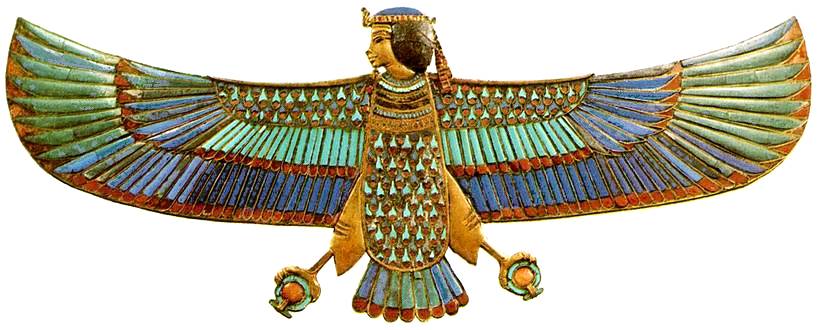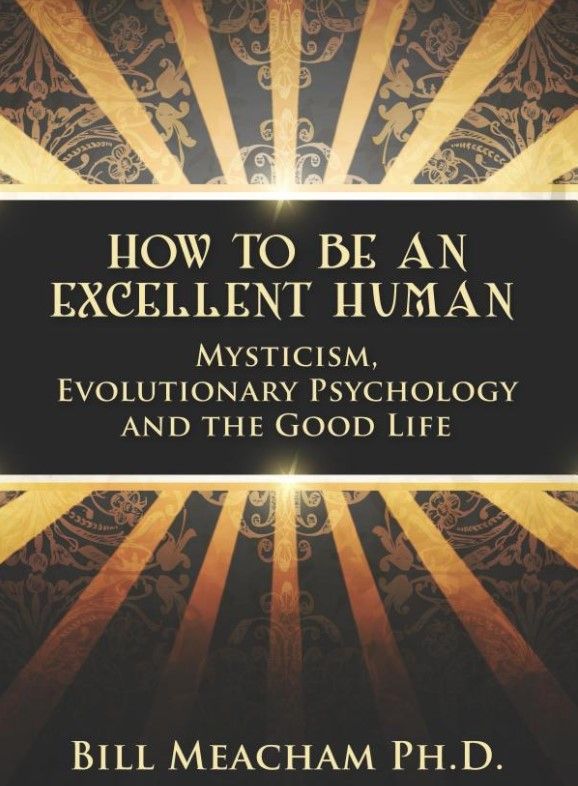The Soul is a Point Of View
One of the artifacts found in the tomb of king Tutankhamun in Egypt is a small figure made of gold and precious stones, quite striking, that has the head of the king and the body of a falcon, with outstretched wings. Each talon grips a round, circular object. It is about a foot wide, and was laid on top of the dead king’s sarcophagus at the belly. It represents his ba, or soul.

“Soul” may not be quite an accurate translation of ba. The ba, in Egyptian mythology, was that part of a person which could travel after death. That’s why it is pictured with wings; it was not constrained to the physical body. But it was only one aspect of the person; others included the physical body itself (khat), the force that animated the physical body (ka), and an immortal part that lived on with the gods after successfully undergoing trials after death (akhu). The akhu, the Egyptians believed, came into being when the ka and ba united.
Nowadays we look on this complicated mythology with bemusement, believing it to be a pre-scientific world view that has no meaning for us, as we have transcended such primitive beliefs. But there is something in our experience from which these ideas arose, and it might be useful to examine it.
Where would the notion come from that some aspect of us can travel around while our bodies remain still? Surely from our dream life. In our dreams we go places, see and do things, interact with people, and sometimes even fly. When we wake up we are again constrained to our body and we recognize that our travels were only a dream. But it was we ourselves who inhabited the dream. We have memories that tell us so. What could we be, who sometimes are bottled up in our body and yet can sometimes travel without that hindrance?
A phenomenological examination of our own experience gives us some insight.[1] If we want to find out who we are, inspecting our own first-person experience of ourself is a good method. And what does this inspection tell us? Two things. The first is that what we commonly take ourself to be is actually a conglomeration of many things: perceptions, feelings, thoughts, bodily sensations, habitual actions, deliberate actions, beliefs, desires, and many more, all organized in an ongoing pattern but none of which are constant. If we examine our experience carefully, we find no specific unchanging thing which is ourself. We are not a substance; instead, we are process, an unfolding pattern of change. The pattern has some constancy, like the flame of a candle, but everything within the pattern is continually altering, moving and transforming.
But it is not a just any pattern that we experience as ourself. It is a pattern of elements that is organized around a center, around a point of view. It is our experience that we are directly acquainted with, not somebody else’s. And we know it from the “inside,” so to speak, not externally as we know everything else. We see the outside of trees, people, animals, etc., but we know directly our own experience, and only our own experience. Who or what is the knower?
That is the big mystery. There is nothing in our experience that is the experiencer. Anything that we can identify is an object of experience, not that which experiences the object. You might think of yourself as your body, but who experiences the body? You might think of yourself as your most intimate, deep-seated beliefs and desires. But even those are things you are conscious of. Who are you, the one who is conscious?
The answer is, you are nothing. You have no substance apart from what is before you in consciousness. As Sartre says, “Nothingness lies coiled in the heart of being.”[2] In a sense, you are not there at all. You are just a point of view.
And that’s why the idea of the ba, which can travel around like a bird after death, has some plausibility. If you are just a point of view, you can be a point of view on anything. You don’t have to be limited to what you experience via the senses. What happens after death is something none of us knows for certain, of course, but many believe that we do experience something after the demise of the physical body; and what we experience then will be a consequence of what we experience now. According to the dualism common to many religions, we will experience rewards or punishments in the afterlife as a result of what we do in this life. In the monistic view of the mystics, what we experience then will not be a reward but a continuation of what we experience now. The external circumstances will be radically different, of course, but not our inner state. The manner in which we habitually experience this life, our approach or attitude toward our world, will continue after death, be that love, harmony and beauty or resentment, discord and ugliness. It is up to us to choose.
Such considerations may be convincing to those who believe in an afterlife. But even if you don’t, at least the following suggests itself: we need not think of ourself as anything we experience, which means we can have a certain distance from what happens to us. In the West, this is the wisdom of the Stoics. Whatever befalls us, most of which is out of our control, we can maintain an inner equanimity, an inner poise that does not depend on external circumstances. In the East, this is the tranquility that arises from the insight neti, neti (not this, not this), the realization that our essence is not anything of which we are conscious, either in the outer objective world or the inner world of our own thoughts, feelings and impulses. Such tranquility, known as Shanti (peace), is said also to be full of bliss (Ananda). We need not wait for an afterlife to experience it; it is available right now.
But even the bliss of tranquility or equanimity is not enough. Recall that the ba of awareness is only one aspect of the human being. Another is ka, the animating force, the force that causes us to move, to desire, to strive and to accomplish. The nothingness that lies in the heart of our being is more than mere awareness; it is also activity. That which is most deeply and truly ourself, the unobservable center around which experience is organized, is also that from which action emanates.
The Egyptians believed that when the ba and the ka were united, then one would become immortal. Translating this to less religious terms, we can say that when our actions reflect the insight that we are not anything we might identify with, then they become selfless. Instead of narrowly grasping at our own gain (or altruistically working for another’s gain at the expense of our own) we can act as an element in a larger harmony that works for the good of all things. To do so requires a certain humility, a certain recognition that in our limitation we must rely on a greater wisdom. And it requires a certain courage, a certain boldness of initiative, that leads us to act decisively when prompted by the upwelling of inspiration that comes from the unity of awareness and action that is our very being.
The ba-bird holds in each talon a circle, the symbol of eternity. When ba and ka are united, we are alert, active and at peace in the sunshine of the endless Now.
The philosophical discipline of phenomenology is the exercise of examining our own experience without bias. The investigator inspects his or her own experience directly instead of using intermediary channels such as oscilloscopes to measure brain waves or psychological experiments to measure attitudes and responses. The phenomenologist examines, not the objects of experience (bridges, trees, people, art, quarks, and so forth), but the experience itself, how those objects appear to us. The phenomenologist attempts to do this without bias, without letting what we already know or believe get in the way of just noting what is present in the experience. Buddhist monks and phenomenological investigators share some similarity in this regard: both just pay attention to what is present in experience, without interpreting it as anything else. It is a radically first-person point of view. ↩︎
Sartre, Being and Nothingness, p, 21. ↩︎
References
Alchin, L.K.. “Purpose of King Tut’s Tomb. On-line publication, URL = http://www.king-tut.org.uk/tomb-of-king-tut/purpose-of-king-tuts-tomb.htm as of 20 May 2011.
Deurer, Richard. Egypt Art Site, “Symbols and Definitions.” On-line publication, URL = http://www.egyptartsite.com/symlst.html as of 20 May 2011.
Evans, Elaine A. “Ancient Egyptian Ba-bird.” On-line publication, URL = http://mcclungmuseum.utk.edu/research/renotes/rn-14txt.htm as of 20 May 2011.
Sartre, Jean-Paul. Being and Nothingness, tr. Barnes, Hazel E. New York: Gramercy House, 1956.
Seawright, Caroline. “The Ancient Egyptian Concept of the Soul.” On-line publication, URL = http://www.thekeep.org/~kunoichi/kunoichi/themestream/egypt_soul.html as of 20 May 2011.
Smith, David Woodruff. “Phenomenology” in the Stanford Encyclopedia of Philosophy. On-line publication, URL = http://plato.stanford.edu/entries/phenomenology/ as of 20 May 2011.
Tales of King Tut’s Blog. Image of Ba-bird. On-line publication, URL = http://blog.talesofkingtut.com/wp-content/uploads/batut.jpg as of 20 May 2011.
Tour Egypt. “The Ancient Egyptian Ba.” On-line publication, URL = http://www.touregypt.net/featurestories/ba.htm as of 20 May 2011.
Wikipedia. “Phenomenology (philosophy).” On-line publication, URL = http://en.wikipedia.org/wiki/Phenomenology_(philosophy) as of 20 May 2011.

How To Be An Excellent Human
Mysticism, Evolutionary Psychology and the Good Life by Bill Beacham, Ph.D.

